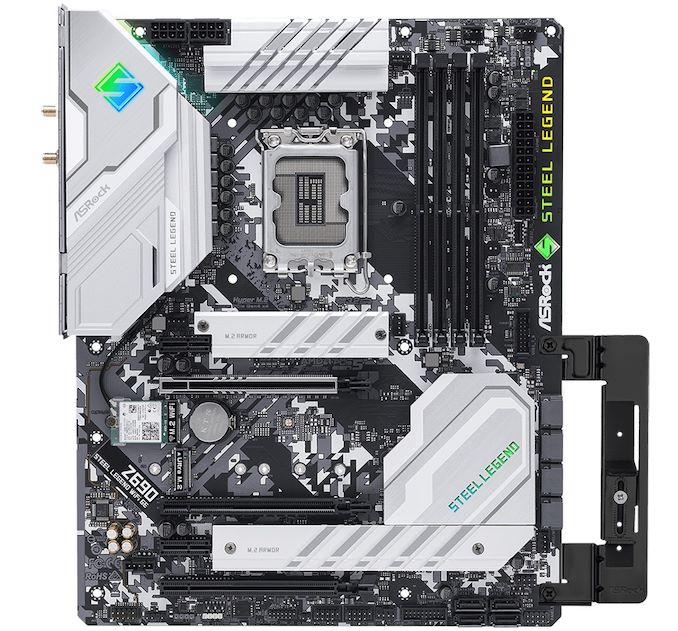The Intel Z690 Motherboard Overview (DDR4): Over 30+ New Models
by Gavin Bonshor on November 24, 2021 2:00 PM ESTASRock Z690 Steel Legend WIFI 6E & Z690 Steel Legend (DDR4)
Another key series in ASRock's stack returns, which targets more of the entry-level to mid-range with a 'lighter' aesthetic. The ASRock Z690 Steel Legend WIFI 6E (DDR4) and the Z690 Steel Legend (DDR4) is another segmented product range differentiating its models between DDR5 and DDR4 memory compatibility, with the Steel Legend currently only available with support for DDR4. The ASRock Steel Legend series blends a black and urban camouflage printed PCB, with white and silver heatsinks, including elements of RGB LED's within the rear panel cover, chipset heatsink, and the Steel Legend logo on the right-hand side of the board.
On the PCIe front, there's one full-length PCIe 5.0 x16 slot, one full-length PCIe 4.0 x4 slot, one full-length PCIe 3.0 x4 slot, and one PCIe 3.0 x1 slot. The Steel Legend models benefit from the full allocation of eight SATA ports from the Z690 chipset, while it also includes three M.2 slots, two with PCIe 4.0 x4 M.2 support, and one with PCIe 3.0 x4/SATA support. In the top right-hand corner are four memory slots, with support for DDR4-5000 and a maximum capacity of up to 128 GB.
The ASRock Z690 Steel Legend WIFI 6E model includes a Wi-Fi 6E CNVI, while the regular Z690 Steel Legend does not. This is the only difference between both models, everything else is the same.
On the rear panel, both models include one USB 3.2 G2 Type-C, one USB 3.2 G2 Type-A, and four USB 3.2 G1 Type-A ports. For users looking for USB 3.2 G2x2 Type-C support, ASRock includes one front panel header for this. Also on the rear panel is an HDMI 2.1 and DisplayPort 1.4 video output pairing, while wired networking is handled by a Realtek RTL8125BG 2.5 GbE controller. For onboard audio, ASRock is using a Realtek ALC1220 HD audio codec which powers five 3.5 mm audio jacks and S/PDIF optical output, while a PS/2 combo port and BIOS Flashback button finish off a modest rear panel offering.












42 Comments
View All Comments
meacupla - Wednesday, November 24, 2021 - link
Those boards are probably still stuck in the Pacific.Mat-mat - Thursday, November 25, 2021 - link
Why not include the Z690 TORPEDO, Z690 ACE, Z690 FORCE, Z690 Taichi, Z690 AORUS XTREME and Z690M DS3H DDR4 (not yet released).By the way, love the fact that the Phantom Gaming 4 boards look no-nonsense in style, while it has DrMOS MOSFETs for VRM power delivery.
PlasticMouse - Thursday, November 25, 2021 - link
Small typo: Previously with 11th gen (Rocket Lake), Intel upheaved it from a PCIe 3.0 x4 uplink on Z490 to a PCIe 3.0 x4 (x8?) uplink on Z590. With Z690, the uplink is now fully-fledged PCIe 4.0 x8 lanes to interconnect things.GarBaGe - Thursday, November 25, 2021 - link
"Intel upheaved it from a PCIe 3.0 x4 uplink on Z490 to a PCIe 3.0 x4 uplink on Z590. With Z690, the uplink is now fully-fledged PCIe 4.0 x8 lanes to interconnect things."This is wrong. Probably just a typo, since the author uses a phrasing which suggests it is a typo.
Z490 has 4 links PCIe 3 from CPU to chipset.
Z590 has 8 links (not 4) PCIe 3 from CPU to chipset
Z690 has 8 links PCIe 4 from CPU to chipset.
My question to Intel: If Z690 is supposed to be your first PCIe 5 platform, why not use PCIe 5 from CPU to chipset instead of PCIe 4?
DazFG - Thursday, November 25, 2021 - link
what listing motherboards with diagnostic panels for overclockers, or how many power phases.cgull.at - Thursday, November 25, 2021 - link
This has been irritating me a bit for a while: "Over 30+ new models"That's redundant. It's like saying "More than more than 30 new models". Pick one or the other. Please?
T2daroy - Thursday, November 25, 2021 - link
I'm considering the MSI MPG Z690 Edge WIFI DDR4. What are your thoughts on this?quantumshadow44 - Thursday, November 25, 2021 - link
}}}While Intel states that it includes an integrated 2.5 GbE MAC/PHY, this is a little nonsensical, as wired ethernet still requires a MAC/PHY as an attached PCIe controller. This means regardless of whether a vendor is using a Gigabit, 2.5 GbE, or even 10 GbE, it connects the exact same way to the PCIe interface.Can someone explain to me why is it "nonsensical"? Thanks.
GreenReaper - Saturday, November 27, 2021 - link
I think the assertion is that the chipset doesn't contain anything to enable this. It's like "you could buy [a motherboard with] a PCIe-based 2.5Gbps Ethernet solution, and it could be from Intel, so we'll list it as a feature".Conversely, for 1Gbps, the Z690 spec sheet lists: "Intel® Integrated 10/100/1000 MAC: Support for the Intel® Ethernet Connection I219-V" - https://ark.intel.com/content/www/us/en/ark/produc...
If you read the datasheet for that it suggests that the I219-V basically turns one of the PCIe links to the PCH ("chipset") into a half-speed Gen1 2.5Gbps connection - but it's not actually the PCIe protocol, it sends Ethernet packets from the I219-V PHY to be handled by the PCH. It also works in SMBus mode at 10Mbps to provide functionality when the machine is a lower-power state.
There is a lot of wake-up functionality which means it has to be able to detect bit patterns, direct-addressed IPv4/6 wakeups, etc, but it relies on chipset features to otherwise process packets.
ScottSoapbox - Saturday, November 27, 2021 - link
"Intel upheaved it from a PCIe 3.0 x4 uplink on Z490 to a PCIe 3.0 x4 uplink on Z590."